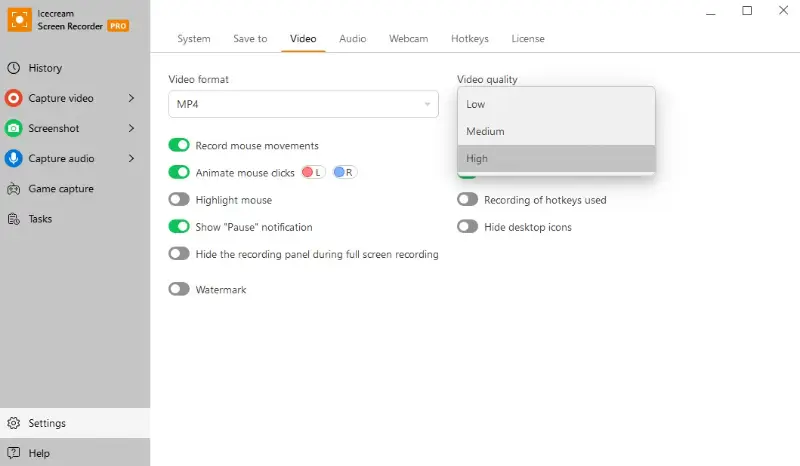Why Are My Screen Recordings Blurry?
Capturing comes in handy for all sorts of things - making video guides, showing off gaming moments, grabbing presentations, or saving online meetings. But here’s a question lots of people run into: "Why are my screen recordings blurry?"
Let’s break down the main reasons your captures turn out fuzzy, and more importantly, what you can actually do to fix it.
Doesn’t matter if you’re a pro at this or starting out. Knowing what causes blurry videos can bring a huge difference in how sharp your clips look. Let’s get into it.
Why are my screen recordings blurry?
Low-quality or pixelated footage is just plain frustrating, especially when you’re trying to record your screen to show something important or walk someone through a process. Here’s what might be going wrong:
| Factor | Description |
|---|---|
| Resolution Controls | If you grab at a low pixel count, your visuals turns out blurry, particularly if your original assets seem lucid. |
| Frame Rate | When the frame rate’s too low, motion gets choppy and everything starts to look bad. |
| Compression | Cranking up downsizing saves space, but you lose detail and clarity. |
| Bitrate | Without enough bitrate, you’ll see artifacts in your content. |
| Hardware Performance | If your computer or graphics card can’t keep up, you get laggy visuals. |
| Software Properties | The way you set up encoding, quality, or capture areas changes how good your film looks. |
| Method | Not all screen recording programs are created equal - some give better fidelity than others. |
| Background Processes | Too many things running in the background slow down your system and drag down definition. |
| Screen Scaling | If these settings are off, your shot loses its crispness. |
| Playback Device | Sometimes it’s not your output - it’s the media player or device that messes up the richness. |
How to fix a blurry video recording?
First of all, check the original source. If it’s already pixelated, there’s not a lot you can do. But if it has happened during capturing or because of optimization, you’ve got options to clear blurry videos.
1. Use reliable screen recording software
Icecream Screen Recorder is a safe option. It’s easy to apply and loaded with tools. What really helps? Tweaking the specifications before you hit the button.
- The utility gives you quality presets: low, medium, or high. Always go for the uppermost fidelity. That way, you cut down on reduction and hold your footage sharp.

2. Check compression settings
Ensure that your screen recording software is set at the best resolution and frame rate it can handle.
- Shoot in 1080p (1920x1080) or 4K (3840x2160) for the cleanest images.
- Configure the frame rate to 30 or 60 fps. This will maintain smooth playback.
Crank up the data rate if you care about fidelity, but remember that heavier files are inevitable. Experiment with the numbers until you find the sweet spot.
Don't overlook audio minimization configuration. Choose a codec that hold sound clarity while minimizing size.
If you don’t care about storage space, go with lossless reduction. Just be ready for some seriously large materials.
3. Proper encoding
Go with formats that handle high-quality encoding well - MP4 is a solid pick.
Select a codec that gives you a good mix of compaction and density. H.264 (AVC) works almost everywhere and does a great job keeping weight down without wrecking the picture. If you want even better definition at lower volume and you’re not worried about whether every gadget supports it, try H.265 (HEVC).
4. Optimize hardware
To prevent blurry screen recordings, you'll you need to dial in your peripherals and software parameters.
Recommendations focused on equipment to clear up blurry videos:
- Get a strong graphics card. This will prevent lag, especially when filming games or anything with a lot of motion. A dedicated GPU with plenty of VRAM makes a big difference.
- You need a fast CPU. Look for a multicore processor with high clock speeds to help your system encode footage in real time.
- Don’t skimp on RAM. For hefty files or substantial multitasking, 8 GB is the minimum, but 16 GB (or more) is better.
- Swap out an old hard drive for an SSD. They read and write data much faster, so you won't experience slowdowns or stuttering when saving huge movies.
- If you’re capturing from a game console or camera, utilize a dedicated acquisition device. They manage the workload much easier than regular desktop screen recorders and deliver improved results.
- Update your graphics card drivers, monitor firmware, and grabbing software. Staying current helps avoid glitches and preserves the integrity of your resources.
5. Stable internet connection
Planning to record live streams or grab content online? You require a steady internet signal - seriously, nothing ruins a visual like dropped frames or choppy clip.
If you can, plug your computer straight into your router with an Ethernet cable. Wired connections almost always beat Wi-Fi for stability and clear video playback.
Double-check your internet plan, too. Verify you’ve got enough bandwidth for broadcasting and uploading without hiccups. A reliable router really pays off, especially if it can handle heavy data traffic. Try to place it somewhere high up and out in the open, so walls and furniture don’t get in the way.
6. Reduce background processes
Close any programs running in the background that you don't need for your task. This will free up system resources.
If you're catching data from a web browser, try to minimize the number of tabs you have open. It frees up memory and keeps your PC running smooth.
Tips to prevent blurry screen recordings
- Set your detail level to at least 1080p. Match it with your display.
- Stick with a steady frame rate (aim for 30 FPS or higher).
- Pick reliable software.
- Close background utilities to lighten the load on your system.
- Turn on hardware acceleration if you can.
- Tweak the bitrate and quality settings for the best results.
- Keep the capture area tight and focused.
FAQ
- What is the ideal resolution?
- Choose dimensions that match - or exceed - your screen’s native display. For example, if your monitor supports 1080p or 4K, apply that to achieve the sharpest results.
- Why are my uploaded recordings blurry?
- Platforms like YouTube and social media compress files to save space, which lowers the visual clarity of your films.
- Can internet speed cause blurry videos during live streaming?
- Yes. A slow or unstable connection forces the broadcast to reduce bitrate, resulting in a less crisp footage.
Conclusion
Achieving clear screen recordings is crucial for effective communication and viewer engagement. By understanding the common cases of blurry videos you can take proactive steps to enhance the quality of your clips.
By addressing these factors, you can produce professional-grade content for tutorials, presentations, or any other purpose. With the right approach and tools, you can sharpen fidelity, allowing your blog to shine.


